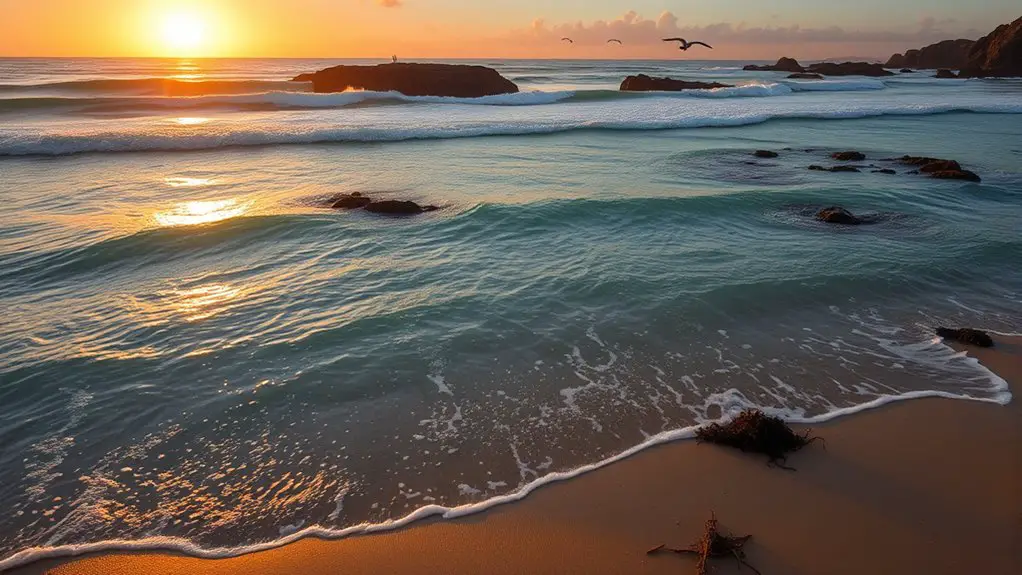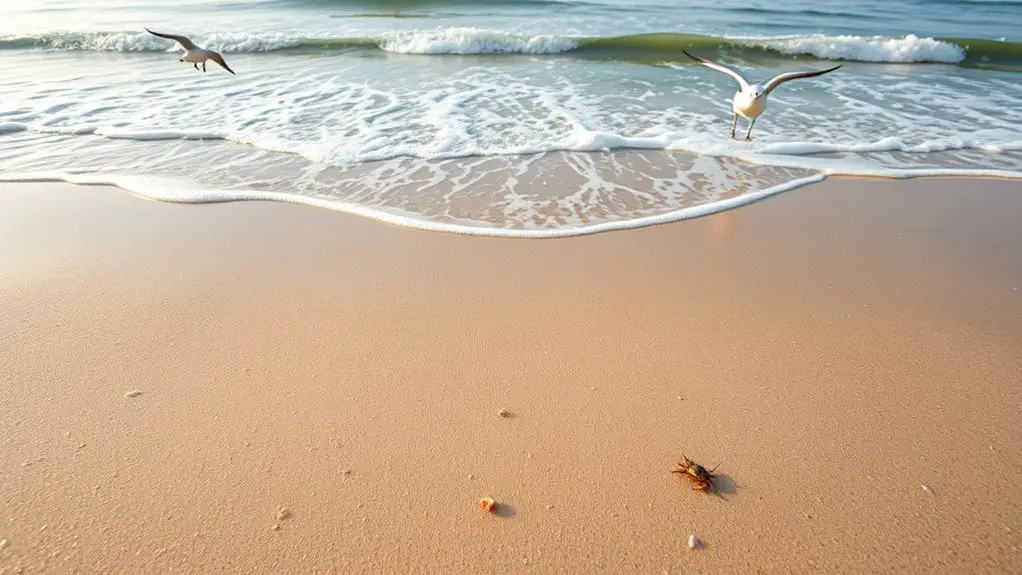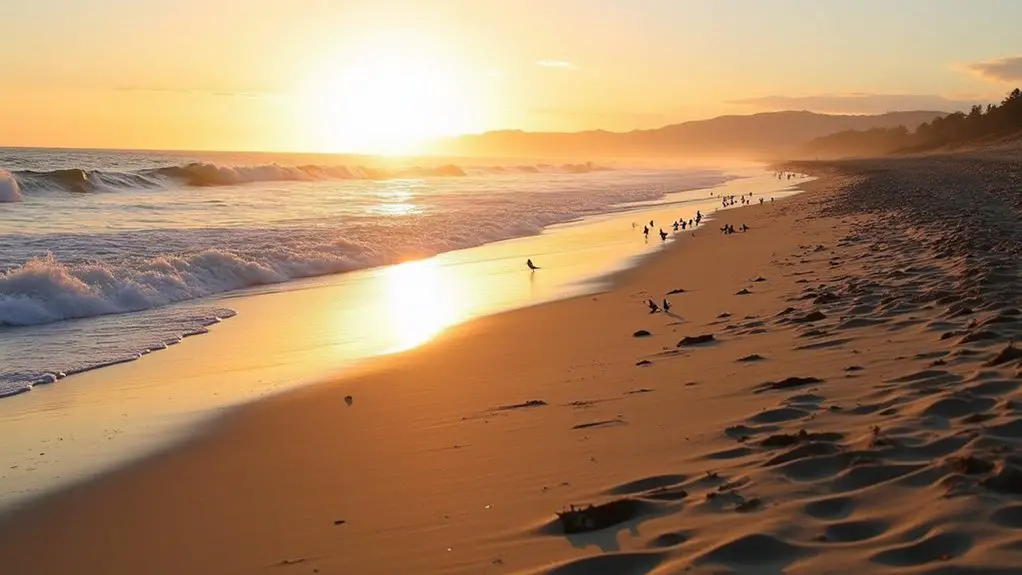Look for underwater structure like sandbars, troughs, and deep holes when surf fishing. Cast into darker water areas (troughs) between breaking waves, and target spots where birds are diving or baitfish are jumping. Prime North American locations include Montauk for striped bass, North Carolina’s Outer Banks for red drum, and Gulf Shores for year-round action. Don’t overlook man-made structures like jetties that create current breaks. The right beach structure can dramatically increase your catch rate.
Surf Fishing Highlights
- Look for darker water between sandbars, indicating troughs that serve as fish highways.
- Cast near jetties, piers, or rock formations that create current breaks and attract baitfish.
- Target areas with visible signs of life like diving birds or jumping baitfish.
- Fish the deep holes (4+ feet at low tide) that predatory fish use as ambush zones.
- Time casts during incoming tides when fish move closer to shore to feed.
What Makes an Ideal Surf Fishing Location
Five essential elements transform an ordinary stretch of shoreline into a surf fishing paradise.
Five key elements elevate a simple beach into prime surf fishing territory worth exploring.
You’ll want to look for underwater structure (sandbars, troughs, deep holes), water movement (rip currents, gutters), diverse substrate (rocky areas or shifts between sand and rock), multiple nearby fishing zones, and signs of life (birds diving, baitfish jumping).
The most productive spots combine these elements—think points where currents meet, jetties creating ambush zones, or deep holes adjacent to sandbars.
During low tide, scout locations to identify these features. Jetties create habitats![]() and serve as excellent fishing spots by concentrating fish in one area.
and serve as excellent fishing spots by concentrating fish in one area.
Predator fish often lurk at the edges between different water types, making these transition zones![]() particularly attractive for successful surf fishing.
particularly attractive for successful surf fishing.
Watch for colliding waves![]() near structures as they collect food and attract various fish species that are eager to feed.
near structures as they collect food and attract various fish species that are eager to feed.
North American Surf Fishing Hotspots
Now that you understand what makes a productive fishing spot, let’s explore the premier surf fishing destinations across North America.
The East Coast offers legendary options—Montauk’s famous bass blitz from September through November will leave you breathless, while North Carolina’s Emerald Isle delivers diverse catches throughout the day.
Down south, Florida’s Apalachicola Bay hosts over 100 fish species year-round (talk about options!).
When fishing in North Carolina, be sure to check out Bogue Inlet Pier![]() , which is especially popular among local anglers for its excellent access and consistent catches.
, which is especially popular among local anglers for its excellent access and consistent catches.
The Outer Banks in North Carolina provides outstanding opportunities for targeting red drum![]() and bluefish along its barrier island beaches.
and bluefish along its barrier island beaches.
Don’t overlook the West Coast, where Orange County beaches yield record-size corbina and San Diego’s warm waters attract halibut and jumbo surf perch alongside inshore fishing![]() for Calico Bass, Rockfish, and Halibut during winter months.
for Calico Bass, Rockfish, and Halibut during winter months.
Whether you’re chasing stripers in New England or sharks in California, America’s coastlines have you covered.
International Destinations for Trophy Surf Catches
Beyond America’s shores, where ambitious anglers seek the ultimate trophy catches, international beaches offer unparalleled surf fishing experiences.
Beyond shorelines lies a world where dedicated anglers discover extraordinary fishing adventures waiting to be conquered.
The Caribbean’s crystal-clear waters host year-round targets like tarpon and bonefish, while Cabo San Lucas delivers world-class action when summer currents bring yellowfin tuna within casting range. For dedicated anglers, June through August in Cabo sees peak activity![]() for both yellowfin tuna and dorado in accessible shore waters.
for both yellowfin tuna and dorado in accessible shore waters.
You’ll find South Africa’s Wild Coast particularly rewarding—the Atlantic-Indian Ocean confluence creates a species bonanza including kabeljou and galjoen. The region is renowned for having some of the best Rock & Surf fishing spots in the world.
Don’t overlook Australia’s extensive shorelines, where Western Australia’s currents attract massive salmon, or New Zealand’s deep beaches, where you’ll battle trophy snapper in cooler temperate waters. In Guatemala’s Iztapa region, the Pacific coastline offers exceptional surf fishing opportunities with vast yellowfin schools![]() invading the nearshore waters from January through June.
invading the nearshore waters from January through June.
Seasonal Patterns and When to Fish Where

While seasoned surf anglers chase trophy catches across international waters, understanding the right timing for your local shoreline can be just as rewarding.
Your fishing calendar should adapt to regional rhythms—Northeast beaches peak from late spring to early fall (think striped bass and flounder), while Gulf shores offer year-round action.
You’ll catch more by matching moon phases with tides; full and new moons typically trigger feeding frenzies. Environmental conditions like barometric pressure![]() changes can trigger aggressive feeding behavior in many saltwater species.
changes can trigger aggressive feeding behavior in many saltwater species.
Dawn and dusk are magic hours in summer, but winter might flip the script to midday bites.
Remember: fish are cold-blooded opportunists—their metabolism dances with water temperature! In Indian Pass, fall months offer exceptional inshore fishing![]() for Redfish, Speckled Trout, and Flounder. For bluefish enthusiasts, target areas from Surf to Deeper
for Redfish, Speckled Trout, and Flounder. For bluefish enthusiasts, target areas from Surf to Deeper![]() zones using GOTCHA plugs or live bait from spring through fall.
zones using GOTCHA plugs or live bait from spring through fall.
Reading Beach Structure for Better Surf Fishing
Even experienced anglers can walk right past prime fishing spots if they don’t know what to look for beneath the water’s surface. The key is understanding beach structure—nature’s fishing map.
Sandbars reveal themselves when waves rise and break over them, creating fish-attracting turbulence. Cast into the darker troughs between bars where fish highway systems form.
Don’t overlook holes (deeper pockets with calmer water) or points (beach protrusions with scooped-out bottoms)—both are ambush zones for predators. Run-outs or rips can be identified by a steady flow of surf suds![]() moving away from the beach.
moving away from the beach.
Man-made structures like jetties and breakwaters? Pure gold! They attract baitfish and create current breaks where big fish lurk.
The most productive beach areas often feature a deep trough![]() of at least 4 feet at low tide, creating essential habitat for larger predatory fish.
of at least 4 feet at low tide, creating essential habitat for larger predatory fish.
Essential Gear for Different Surf Fishing Destinations
Although successful surf fishing demands skill and knowledge, your equipment often makes the difference between landing that trophy catch or going home empty-handed.
Your rod selection should match your environment—opt for 10-12 foot surf rods when fishing powerful ocean breaks, paired with 4000-6000 size spinning reels.
Match your rod to the battle—powerful breaks demand 10-12 foot surf rods and 4000-6000 spinning reels.
For sandy beaches with strong currents, pack pyramid sinkers (1-4oz) and circle hooks (sizes 2-5).
Don’t forget the essentials: a sturdy bait knife, sand spikes, and waterproof tackle storage. Beach carts are lifesavers for remote locations! Balloon tires![]() are essential for navigating through soft, loose sand beaches efficiently. The Sea Striker PVC Sand Spike
are essential for navigating through soft, loose sand beaches efficiently. The Sea Striker PVC Sand Spike![]() is an affordable option at $7.99 that keeps your rod secure while you wait for the bite.
is an affordable option at $7.99 that keeps your rod secure while you wait for the bite.
Dress appropriately for your destination—quick-dry clothing for sunny spots, layered options for variable conditions, and always wear polarized sunglasses. Monitoring weather forecasts![]() before your trip allows you to prepare for changing conditions and optimize your fishing strategy.
before your trip allows you to prepare for changing conditions and optimize your fishing strategy.
Species-Specific Surf Fishing Strategies

Since different fish species require unique approaches, mastering species-specific tactics will dramatically improve your surf fishing success rate.
For striped bass, cast beyond sandbars during high tide with live bunker or eels.
Pompano love sandy beaches with gentle surf—try double dropper rigs with shrimp and those eye-catching beads (they’re suckers for bling!).
When hunting bluefish, remember their chompers will make quick work of weak leaders, so beef up your terminal tackle![]() .
.
Redfish prowl Gulf Coast shorelines, striking cut mullet during incoming tides, while speckled trout prefer early morning jigs in tidal channels.
Your tackle box isn’t one-size-fits-all—neither should your strategy be!
During winter months, switch to lighter tackle![]() when targeting most species, as fish become more lethargic and require a more subtle presentation.
when targeting most species, as fish become more lethargic and require a more subtle presentation.
In Ocean City, New Jersey, you’ll find an abundance of diverse species![]() including bluefin tuna, fluke, and striped bass that make it a premier surf fishing destination.
including bluefin tuna, fluke, and striped bass that make it a premier surf fishing destination.
Local Regulations and Conservation Considerations
While you’re perfecting your species-specific tactics, don’t forget that the law has its own set of rules for the surf fishing game.
Before casting, make sure you’ve got the proper licenses—most states require one for recreational fishing (and yes, that automatically registers you with the feds).
Keep an eye on size and bag limits; that 5-inch blue crab might look keeper-worthy, but in Massachusetts, it’s a no-go.
Certain areas implement seasonal closures to protect spawning fish, especially around whale migration periods.
And remember, some gear just isn’t welcome at the party—leave those crab traps at home during no-trap seasons!
Frequently Asked Questions
How Do I Protect My Gear From Sand and Saltwater Damage?
To protect your gear from sand and saltwater damage, keep rods elevated on sand spikes and store smaller items in sealed containers.
After fishing, always rinse everything with fresh water immediately—salt’s a silent killer!
Apply lubricant to reels regularly, and dry all equipment completely before storage.
Don’t leave gear directly on the beach; use a surf cart instead.
For extra protection, invest in rod sleeves and corrosion-resistant tackle specifically designed for saltwater use.
Can I Surf Fish Effectively Without Wading Into the Water?
Standing on solid ground doesn’t mean your fishing dreams are sinking! You can absolutely surf fish effectively without wading.
Target rip currents, troughs, and points where fish naturally funnel close to shore. Equip yourself with a longer rod for distance casting, and consider fishfinder rigs or drone delivery for reaching those prime spots.
During high tide, fish move closer to shore—your perfect opportunity! While wading expands your reach, your fishing success isn’t underwater—it’s in your strategy and technique.
What Moon Phases Produce the Best Surf Fishing Results?
You’ll find your best surf fishing during full and new moon phases, when spring tides create stronger water movement that stimulates fish activity.
These lunar peaks align perfectly with Solunar Theory‘s predicted feeding times! Full moons illuminate night fishing (great for nocturnal feeders), while new moons trigger more daytime action.
During waxing and waning phases, adjust your approach—use faster lures during full/waxing periods and slower, subtler baits during new/waning times when fish are less aggressive.
How Do Changing Barometric Pressures Affect Surf Fishing Success?
When the sky’s mood swings affect the ocean’s breath, your fishing success follows suit.
You’ll notice that rapidly falling pressure before storms triggers a feeding frenzy—fish go wild for bright, fast-moving lures.
Once low pressure settles in (below 29.6 inHg), they’ll retreat to deeper water.
After storms, when pressure rises, fishing slows as fish adjust.
Surf zone fish feel these changes more intensely than deep-water species, so time your trips just ahead of weather shifts for ideal results.
Are There Smartphone Apps Specifically Designed for Surf Anglers?
Yes, there are several apps tailored for surf anglers.
Fishbrain and Navionics provide detailed coastal maps with depth charts, while Surfline offers beach-specific tide and swell information.
You’ll find ProAngler helpful for saltwater species tips and local fishing spots.
For tracking your success, try Trimble GPS Fish Free or Fishing Chaos.
Don’t forget weather apps like The Weather Channel for conditions that’ll make or break your day.
These digital tools can turn your smartphone into a surf fishing command center!
Conclusion
You’re now equipped to find your perfect surf fishing spot! Remember, “good things come to those who wade” – success requires patience, preparation, and the right location. Whether you’re casting from Florida’s emerald shores or Australia’s rugged coastlines, the techniques and insights you’ve learned will help you read the water, select appropriate gear, and target specific species. Always fish responsibly, respect local regulations, and enjoy the timeless dance between angler and ocean.

